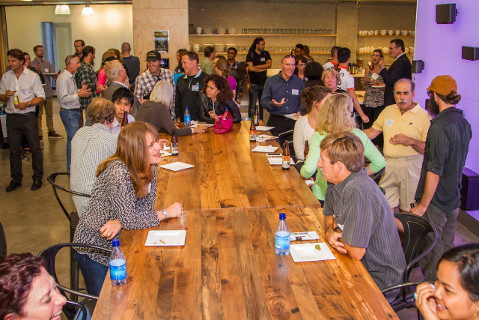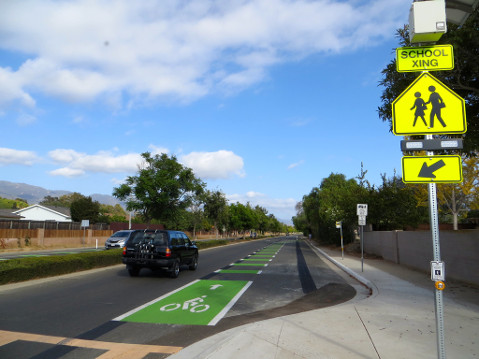Business Benefits from Cycling
Pedaling Is Good for Our Community

Santa Barbara companies, large and small, are discovering that cycling is good for business. In June, over 105 business leaders and elected officials gathered at Sonos for a CycleMAYnia mixer to promote bicycle-friendly businesses. Civic leaders across the country are recognizing that bicycling can be a game changer. Ten years ago, most businesspeople weren’t even thinking about bikes as a part of their business.
Both nationally and locally, civic and business leaders are paying attention to the Millennial Generation’s wish for lively, livable places to work and play. These young people represent the creative class, a talent pool that many companies covet. Richard Florida, an urban studies theorist who coined the phrase creative class, has described these in-demand workers as “less interested in owning cars and big houses. They prefer to live in central locations, where they can rent an apartment and use transit or walk or bike to work.”

As a result, young people today are driving significantly less than previous generations. The Federal Highway Administration reports that between 1995 and 2009 the miles traveled by drivers under 30 dropped from 21 to 14 percent of the total. Even Motor Trend magazine notes that young professionals living in urban areas are less inclined to buy cars and “more likely to spend the money on smartphones, tablets, laptops, and $2,000-plus bikes.”
Bikes are improving the business climate even in cities not ranked as bike capitals or large metropolitan regions. Many are Midwest and Southeastern cities that are competing with Seattle and Silicon Valley to attract technology-based businesses to replace basic industry and manufacturing jobs.
In the 1990s Pittsburgh was an old Rust Belt city with a rapidly aging population. Pittsburgh has two of the finest technology, medical research, and engineering universities in the world. But many Carnegie Mellon and University of Pittsburgh students were leaving the city as soon as they graduated. Civic leaders wanted graduates, like the ones who started Adobe or Sun Microsystems, to stay in Pittsburgh. Bicycle-friendly infrastructure became a symbol for their commitment to making the city attractive to younger people. That strategy is succeeding as business incubators nurture small innovative start-up companies and major technology players such as Google, Apple, Walt Disney, Intel, Microsoft, Oracle, and Yahoo open research offices.
Pittsburgh started by building protected bike lanes in a few key points of the city. The first three lanes are the initial installments in a plan that will see five miles of protected bike lanes built in the next two years. Pittsburgh was one of six cities selected by People For Bikes to participate in its Green Lane Project that takes municipal leaders on tours of cities with state-of-the-art bike infrastructure, such as Amsterdam and Copenhagen. The city already has about 25 miles of off-street bike trails, including many riverfront routes. The new protected bike lanes will help to connect those trails into a network that will make biking safe and accessible in many parts of the city.
Austin, Texas, a fast growing technology hub, is ambitiously expanding its bike infrastructure by shifting from thinking about projects that impact a single street to developing a data-driven plan focused on creating a city-wide bike lane network. It recently opened the first of 10 planned green lanes. Increasingly, technology companies that depend on highly trained engineers are moving to downtown Austin from the isolated suburbs as they compete for younger workers.
In 2008, Memphis was named one of the three worst cities for cycling in America by Bicycling magazine. There wasn’t a single bike lane inside its city limits. Recently, Memphis was honored as the most improved city for bicycling. Memphis achieved that recognition because of the efforts of a coalition of political, business, and community leaders. The city committed to building new bike lanes when repaving city roads. As a result, since the summer of 2010, Memphis has built at least 45 miles of on-street bike facilities. The process wasn’t without conflict. Many merchants feared that removing car lanes would hurt businesses and cause parking confusion. City, community, and business leaders worked together to develop plans that benefited both businesses and all road users.
Minneapolis is another example of a post-industrial city using bicycling to improve urban life for its residents. Community and civic leaders developed plans that are creating a network of off-street trails that cross the city, adding 180 miles of bike lanes to streets, launching a bikeshare programs and building protected lanes to separate cyclists from motor traffic. As a result businesses have started moving back from the suburbs into the city. For example, Accenture, a management consulting company, says good biking opportunities are important to the well-educated 25- to 35-year-olds they seek to hire.
In Minneapolis, the boom in biking is also creating opportunities in the real estate market. Over $200 million in new apartments are being built adjacent to the Midtown Greenway, a bike freeway cutting through the south side of the city. Studies in other parts of the country have shown that bicycle paths can increase property values by providing recreation, transportation, and a sense of community.

Santa Barbara and Goleta are home to many small innovative technology companies that are powered by bight young creative men and women. Many of them are UCSB graduates. Santa Barbara is a paradise for these young professionals. It offers plentiful cafés and restaurants, a tolerant social climate, year-round outdoor recreation, and ample transportation options like biking—not only for commuting to work, but also for after work and, in some cases, over the lunch hour.
Over the next few months, Santa Barbara’s leaders will have an opportunity to stand up for cycling. From Carpinteria to Goleta, companies large and small are embracing bicycling as a way to improve employee morale, invest in the community, increase their bottom line, and expand their customer base. Biking and business pair well in Santa Barbara.



